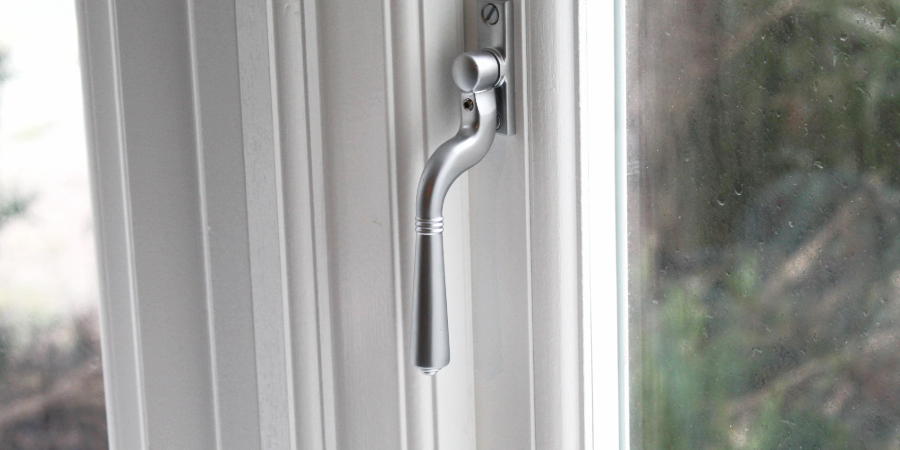Many homeowners consider energy efficiency a key factor when choosing windows for their homes. Because of this, casement windows are often praised for their superior insulation, which helps reduce energy costs. But are they genuinely energy-efficient, and how does the material they are made from impact their overall performance? Here, we’ll explore the energy efficiency of casement windows and compare different materials.
How Casement Windows Work
Casement windows, with their unique side-hinged design that opens outward like a door, create a secure seal when closed. This design feature is a key contributor to their high energy efficiency, as it minimises air leakage and prevents draughts, helping to maintain a consistent indoor temperature. Casement windows’ energy efficiency is also enhanced by their ability to maximise ventilation. During the warmer months, casement windows can be opened fully, allowing fresh air to circulate through the house and reducing the need for air conditioning.
How Materials Affects Energy
The material from which casement windows are made plays a crucial role in their energy efficiency. Let’s examine the pros and cons of different materials:
uPVC Casement Windows
Pros:
- uPVC windows are often marketed as a cost-effective, energy-efficient option
- They are low maintenance and offer decent insulation
Cons:
- UPVC can warp or degrade over time, reducing its effectiveness in sealing draughts
- uPVC is not environmentally friendly, as it is a plastic material that cannot be recycled easily
- While affordable, uPVC may not match natural materials like timber’s longevity or aesthetic appeal
Cost:
- uPVC is usually the cheapest option upfront, but the lower durability and environmental impact can make it less cost-effective in the long term.
Aluminium Casement Windows
Pros:
- Aluminium is durable, low maintenance, and offers sleek, modern aesthetics
- It’s a recyclable material, making it more eco-friendly than uPVC
Cons:
- Aluminium is a highly conductive material, meaning it easily transfers heat and cold. While some aluminium windows are thermally broken (containing a thermal barrier), they are not inherently insulating like other materials.
- Aluminium windows can be more expensive than uPVC or timber options
Cost:
- Aluminium windows are generally more expensive than uPVC and timber, mainly if they include thermal breaks to improve energy efficiency
Timber Casement Windows
Pros:
- Timber, as a natural insulator, is a key factor in the energy efficiency of timber casement windows. Its low thermal conductivity helps keep your home warm in winter and cool in summer
- Timber casement windows offer a timeless, elegant look for both traditional and modern home
Cons:
- Timber windows require periodic maintenance, such as painting or sealing, to prevent rot or weather damage
- They tend to have a higher upfront cost than uPVC
- Timber windows may be more prone to warping or swelling in humid conditions
Cost:
- Timber windows may be more expensive initially, but their durability and energy efficiency offer excellent long-term value
- When obtained from sustainable wood suppliers, they are a more environmentally friendly option. This long-term benefit makes them a smart choice for homeowners and a wise investment
Why Timber is the Best Choice for Energy Efficiency
We believe out of all material used, that timber is the best choice. This is because, while materials like uPVC and aluminium may seem appealing due to their lower costs, timber casement windows stand out for their natural insulating properties. Wood is an excellent barrier to heat and cold, keeping your home comfortable throughout the year without over-reliance on heating or cooling systems. Timber also provides an airtight seal that enhances the already energy-efficient design of casement windows. Unlike uPVC, which can warp over time, or aluminium, which may require added thermal breaks, timber maintains its structure and insulating properties over the long term.
At Wandsworth Sash Windows, we craft all casement windows using high-quality, sustainably sourced timber. This guarantees excellent energy efficiency and makes our windows an environmentally friendly option. You’ll reduce your carbon footprint while investing in windows that enhance the beauty and value of your home.
Exciting Facts About Timber Casement Windows
- Sustainable Choice: Timber is one of the most environmentally friendly materials for windows. When sourced responsibly, wood is renewable, recyclable, and biodegradable
- Timber Longevity: Well-maintained timber windows can last over 60 years, far outlasting uPVC alternatives
Natural Insulation:
- Timber’s natural thermal properties make it up to 400 times better at insulating than steel and 1,800 times better than aluminium.
In conclusion, casement windows are among the most energy-efficient, especially when made from timber. Their design allows for an airtight seal that minimises heat loss, and when crafted from timber, they provide excellent insulation that is hard to match with other materials. This reassurance will make homeowners feel confident in their choice. While the initial cost of timber casement windows may be higher than uPVC or aluminium, their durability, beauty, and natural energy-saving properties make them a wise long-term investment. With proper maintenance, timber windows can last for decades, providing excellent value for money.
If you are considering upgrading your windows to casement windows, please contact us or call 02079247303.

